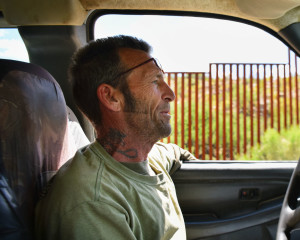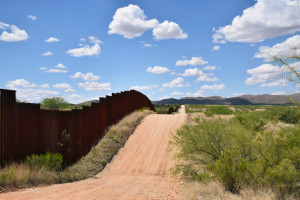
Wind whips through the dry grass at the base of the U.S.-Mexico border fence where Tim Foley stands smoking a cigarette and surveying vast wilderness of the Altar Valley. Here, just west of the Sasabe border crossing, the 20-foot tall steel fencing abruptly gives way to straggling barbed wire as the physical border, so easily drawn on a map, cuts across rugged terrain into the Baboquivari Mountains and the Tohono O’odham reservation.
Foley brings people to this spot to demonstrate what he considers a lack of border security. Places like this are wide open. Anyone can pass through. Not that the fence is stopping anybody anyway, he says.
The founding member of the Arizona Border Recon, Foley, with his loyal pitbull Rocco, leads a group of well-armed volunteers who patrol the desert for people and drugs crossing illegally from Mexico.
For now, the organization, which has been labeled an extremist group by the Southern Poverty Law Center, mainly collects information about the comings and goings on this part of the border, but Foley wants to expand the operation to occupy portions of the border. Afterall, he says, this is war.
A Finger Pointing South
Foley is a man let down by the system.
He was working construction in Phoenix when the Great Recession hit in 2008. He went from making $80,000 a year to $12,000 on unemployment.
“One day I went to work and it was gone,” he says. “I mean, we weren’t even finished with the building yet. Collapsed. They pulled the plug on the money.”

For about a year he traveled the country trying to pick up odd jobs, but he wasn’t making enough to keep up his house payments. It was foreclosed.
“I was that close to walking out the door and setting it on fire,” Foley says, his pale blue eyes wide and piercing with rage. “Because they didn’t see me as a person. They just saw me as a paycheck.”
The banks and the government had failed him, but he had no recourse against them. There was one problem, though, he thought he could fight: illegal immigration.
“It’s not something I wanted to be involved in. It was pretty much forced upon me,” he says, tearing the packaging off a new pack of Marlboros and lighting up.
Like so many others, Foley’s life had been turned upside down, and he thought he had an idea about why.
Having worked in construction, he saw undocumented migrants willing to work for low wages and able to get around their absence of papers. It didn’t seem fair.
“They say, ‘Oh, they’re coming across to do jobs you won’t do.’ Well, that’s bullshit,” he says. “Every white guy I knew growing up went into construction because we didn’t have the best education, so we did manual labor, and we learned it as we went.”
So, convinced that migrants from Mexico were to blame for his losses in life, he drove to the border to take matters into his own hands.
Foley lived out of his car in the desert for the first two months, until he teamed up with a few like-minded men who had a house in Sasabe.
Tucked into the Buenos Aires National Wildlife Refuge, Sasabe feels like a ghost town in the middle of the desert. You’re more likely to cross paths with hawks and vultures than fellow humans. The wide open spaces recall images of the wild west, where cowboys on horseback gallivanted through the desert and executed the law.

But if the idea of a group of armed men roaming the desert to enforce their vision of justice makes you uncomfortable, that’s probably because the word “vigilante” has taken on a bad name these days, says Foley, whose personal quest for justice started in 2009.
After the first guys he teamed up with gave up and left, Foley took over their house, just down the road from Sasabe’s small, white church. He made it into a headquarters for his team of volunteers known as the Arizona Border Recon.
The group is diverse. Mostly ex-military, they come from all over the country, and even from overseas. Doctors, plumbers, young guys looking for something to do–all united by their righteous belief that their camp in desert can secure the southern border once and for all.
“It’s like you guys don’t know what’s going on,” says Clint Dunn, 37, who left his home in Australia to live in Sasabe, Arizona, after seeing Cartel Land, a documentary featuring Foley.
“I came over here to help out you guys because it’s a big problem,” he says. “Somebody’s got to do it.”
Foley’s World
Foley sits at his desk flipping through photographs taken from the six cameras hidden on trails in the desert. Tattoos sprinkle the sun-weathered skin on his neck and arms. He is wearing a heather green shirt stamped with the Arizona Border Recon logo, the kind he hopes to start selling online to raise money. He turns away from the computer, pushing his tortoiseshell glasses halfway up his forehead.
“I don’t do this for myself,” he says. Then corrects. “I do this partially for myself. But, I do it for you. For your family. For every other family that’s up there.”
Down here, Foley is in charge. He organizes the operations. He monitors the cameras. He vets the volunteers, deciding who stays and who goes. He gives interviews to the media and tours of the border to any politician willing to meet him.

Foley isn’t shunning the limelight.
“I have media from around the world coming to talk to me,” he says. He met with producers about making a reality TV show, though he hasn’t decided if he’ll do it, he says.
Every few months, Foley gathers a group of his volunteers to camp out in the desert for a week. They stop everyone they encounter and turn them over to Border Patrol.
They carry guns because it’s dangerous out there. Although they have never had occasion to use them, he says.
“You don’t have to,” he says. Just the sight of the weapons is enough to intimidate people into surrendering.
But most days, Foley is at the headquarters fixing radios or studying the cameras he has scattered across the surrounding desert to watch for migrants and drug mules. He’s usually alone, or with one or two volunteers who are staying with him at the house.
He drives around town or hikes trails near his house with his dog Rocco, always on the look-out.
The Border Patrol does not actively communicate with or endorse the Arizona Border Recon, Tucson Sector officials said in a statement. Private citizens taking matters into their own hands can have “disastrous personal and public safety consequences,” the statement continued.
But that’s just the bureaucrats at the top, according to Foley. The line agents who work near the border rely on him, he says.
“We call them the green mushrooms,” he laughs. “Because they’re fed a lot of shit and kept in the dark.”
Foley doesn’t blame the Border Patrol for their failures, he says. They are limited by the government. But he thinks he could do better. He sees himself as The Wall.
Though they only have volunteers camped out in the desert a few times a year, Foley says he’s starting to work toward longer-term occupation of areas where he knows cartels cross. He boasts that with the right resources, he could end illegal border crossing completely and quickly.
“You would have to purchase little parcels of land along the border and occupy them,” Foley explained. “But I’ve already figured it out. I could do it for one third of the cost of what the government can do it for. And I can probably have it pretty much shut down in two months. The entire border.”
The southern border has been a battleground in the war on drugs and the war on terrorism for years, Foley says. He’s ready to formalize that war.

Foley’s isn’t alone in his thinking. The Arizona Border Recon is built on a legacy of vigilante and militia movements along the U.S.-Mexico border, many of which have faced criticism for their practices in the desert and been labeled hate groups by the Southern Poverty Law Center. Militia members have also been mixed up in legal troubles for everything from murder to child molestation.
But Foley has no doubt in his mission to reclaim the border.
“Once you really start hurting the cartels in their pocketbook, I fully expect things to get violent,” he says. “But we’re not leaving.”
Kendal Blust is a reporter for Arizona Sonora News, a service from the School of Journalism with the University of Arizona. Contact her at ktblust@email.arizona.edu.
Click here for high resolution images.

